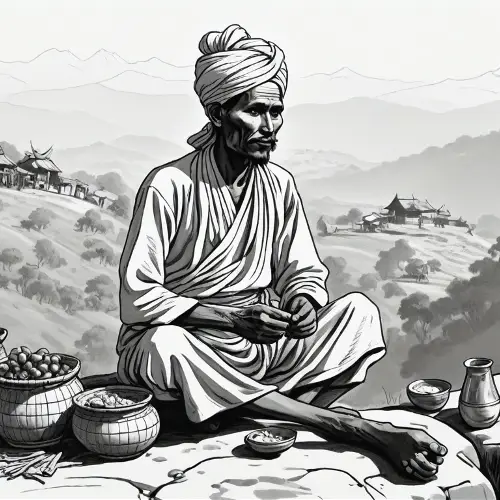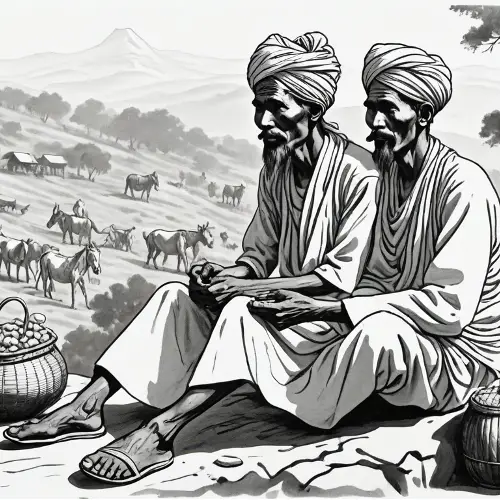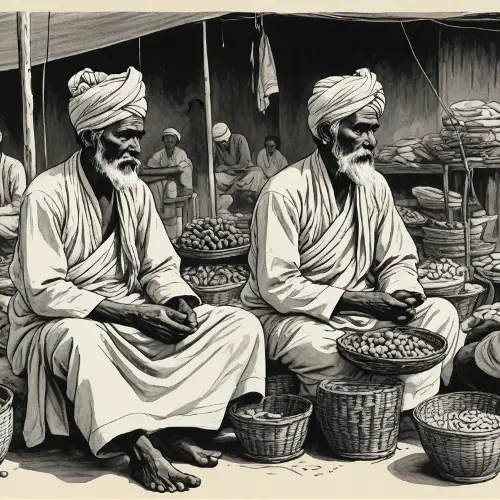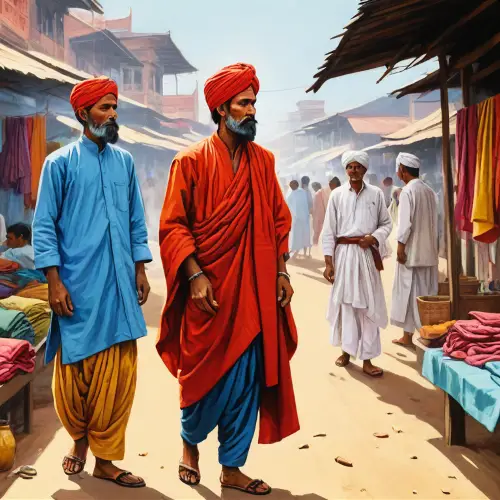The Marwadi School Stage in Burma in 1935 serves as the backdrop for a nostalgic sketch. Picture a modest stage within the school, embodying the architectural and cultural elements of the Marwadi community. Capture the simplicity of the setting with wooden structures and basic decor. On the stage, imagine students dressed in traditional Marwadi attire, engaged in a cultural or educational event. Symbolic elements, such as books, chalkboards, and cultural artifacts, can be incorporated. The sketch should evoke the essence of education, community, and cultural exchange within the Marwadi school in Burma during the mid-20th century.
\Generate historically accurate and culturally immersive images portraying a group of 6-year-old boys engaging in playful gossiping, commenting, and teasing with their teacher in a Myanmar classroom during the year 1928. Pay meticulous attention to period-specific clothing, school setting, and cultural nuances reflective of early 20th-century Myanmar. Capture the innocent yet mischievous interactions, highlighting the camaraderie and dynamics of student-teacher relationships in this historical context. Convey the unique blend of curiosity and playfulness as these young boys share lighthearted moments with their teacher, offering a glimpse into the educational and social aspects of Myanmar in 1928.
Generate an image of a bustling 1940s theater scene in Burma, where the President of Burma stands among a diverse crowd, eagerly watching a captivating performance. The spotlight is on a 13-year-old boy dressed as King Ashoka, delivering a spellbinding theatrical performance, surrounded by intricate props and set pieces that transport the audience to ancient times. Capture the atmosphere of anticipation, cultural richness, and historical resonance in this visually compelling moment. greyscale.
Generate authentic and culturally immersive images depicting a group of young students, approximately 6 years old, engaging in playful gossiping, commenting, and teasing with their teacher in a Myanmar classroom during the year 1928. Pay careful attention to historical accuracy, capturing the period-specific clothing, school setting, and cultural details reflective of early 20th-century Myanmar. Convey the innocent yet mischievous spirit of the children as they interact with their teacher, highlighting the universal aspects of childhood experiences within the unique historical context of Myanmar in 1928. Create a scene that reflects the timeless dynamics of student-teacher relationships in a bygone era.\
Generate historically accurate and culturally rich images portraying students, aged around 6 years, in India and Myanmar in the year 1928, engaging in playful teasing and commenting on their teacher in a Myanmar classroom
principal of a sikh khalsa school talking to one man in his office. year is 1930 in Burma country.
\Generate heartwarming and culturally rich images depicting school children from Myanmar and India, aged around 6, engaging in commentary and teasing with their teacher
16 year rich boy topped in school and in india in standard 10th in year 1935
In a dimly lit Burmese hospital room in 1885, a Marwadi man lies on a wooden bed with closed eyes, wearing a vibrant turban and covered by an intricately patterned blanket. The atmosphere is serene, with a mix of curious onlookers, patients, and concerned family members surrounding him. A dedicated doctor, dressed in period-appropriate attire, examines a medical chart nearby. The scene captures a multicultural tapestry of Burma in the late 19th century, with soft lighting creating a poignant moment of cultural convergence and compassion.
principal of a sikh khalsa school talking to one man in his office. year is 1930 in Burma country.
principal of a sikh khalsa school talking to one man in his office. year is 1930 in Burma country. charcoal style
Imagine a scene in the hill area of Burma in the year 1880. A distinguished man is depicted, wearing a traditional turban, kurta, and dhoti, standing with a sense of grace. His attire is detailed, reflecting the cultural nuances of the region during that period. Beside him, a mule is tethered, carrying goods or belongings, adding an element of daily life in the hills. The landscape around is hilly, with lush vegetation and perhaps a glimpse of distant mountains. The man may be holding a piece of luggage or engaged in an activity, further emphasizing the context of life in Burma during the late 19th century.
Imagine a scene in the hill area of Burma in the year 1880. A distinguished man is depicted, wearing a traditional turban, kurta, and dhoti, standing with a sense of grace. His attire is detailed, reflecting the cultural nuances of the region during that period. Beside him, a mule is tethered, carrying goods or belongings, adding an element of daily life in the hills. The landscape around is hilly, with lush vegetation and perhaps a glimpse of distant mountains. The man may be holding a piece of luggage or engaged in an activity, further emphasizing the context of life in Burma during the late 19th century.
Imagine a scene in the hill area of Burma in the year 1880. A distinguished man is depicted, wearing a traditional turban, kurta, and dhoti, standing with a sense of grace. His attire is detailed, reflecting the cultural nuances of the region during that period. Beside him, a mule is tethered, carrying goods or belongings, adding an element of daily life in the hills. The landscape around is hilly, with lush vegetation and perhaps a glimpse of distant mountains. The man may be holding a piece of luggage or engaged in an activity, further emphasizing the context of life in Burma during the late 19th century.
open air school class in Rajasthan India during 1930. Everyone is sitting below tree and listening to a teacher. charcoal style.
open air school class in Rajasthan India during 1930. Everyone is sitting below tree and listening to a teacher. charcoal style.
Imagine a scene in the hill area of Burma in the year 1880. A distinguished man is depicted, wearing a traditional turban, kurta, and dhoti, standing with a sense of grace. His attire is detailed, reflecting the cultural nuances of the region during that period. Beside him, a mule is tethered. The landscape around is hilly, with lush vegetation and perhaps a glimpse of distant mountains. The man may be holding a piece of luggage or engaged in an activity, further emphasizing the context of life in Burma during the late 19th century.
oad facing clothing shop in year 1837 in myanmar with bamboo roof and bit crowd
Generate authentic and culturally rich images portraying a group of 6-year-old boys engaging in playful gossiping, commenting, and teasing with their teacher in a village school in India during the year 1928. Pay meticulous attention to period-specific clothing, rural village setting, and cultural details reflective of early 20th-century India. Capture the innocence and mischievous spirit of the boys as they interact with their teacher, highlighting the universal aspects of childhood experiences within the unique historical and geographical context of an Indian village in 1928. Create a scene that evokes the charm and simplicity of rural education and social dynamics during that era.
16yr rich boy topped in school and in india in standard 10th in year 1935
Illustrate a serene scene within a bustling market in Burma circa 1880, featuring a charming shop with a distinctive bamboo roof. The focus should be on the architectural beauty and simplicity of the bamboo structure, which was a prevalent building material in traditional Burmese construction.
Envision a scene in the hilly terrain of Burma in the year 1880. A man, adorned in a turban and traditional doti, is seated on a rock or a makeshift surface, savoring a meal. His attire is intricately detailed, reflecting the cultural identity of the region during that period. Beside him, a mule is securely tied, and luggage is neatly arranged nearby, suggesting a pause in a journey or a moment of rest during travel. The hilly backdrop features rugged landscapes, with vegetation and perhaps a glimpse of a winding trail or distant hills. The scene captures a serene moment in the daily life of Burmas hill areas in the late 19th century
Imagine an Indian man in the hilly region of Burma in 1880. Hes sitting on a rock or a simple surface, wearing a turban and a traditional doti. The man is depicted enjoying a meal in a serene setting. Beside him, a mule is securely tied, and luggage is neatly arranged, indicating a moment of rest during a journey. The hilly landscape features rugged terrains with greenery and perhaps a glimpse of a winding trail or distant hills. This scene captures a peaceful moment in the daily life of an individual in the hill areas of Burma during the late 19th century.
Imagine an Indian man in the hilly region of Burma in 1880. Hes sitting on a rock or a simple surface, wearing a MARWADI THIN turban and a traditional doti. The man is depicted enjoying a meal in a serene setting. Beside him, a mule is securely tied, and luggage is neatly arranged, indicating a moment of rest during a journey. The hilly landscape features rugged terrains with greenery and perhaps a glimpse of a winding trail or distant hills. This scene captures a peaceful moment in the daily life of an individual in the hill areas of Burma during the late 19th century.
Generate a detailed line art sketch featuring a Marwadi man seated on a Burmese market street in 1887. The man is wearing a traditional turban and dhoti, facing left, and engaged in selling vibrant cloth materials. Capture the intricate details of his attire, the texture of the fabrics on display, and the historical elements of the bustling Burmese market. Illustrate the street scene with architectural nuances and the lively atmosphere of customers exploring the textile offerings. Emphasize the cultural exchange and trade dynamics in this snapshot of 1887 Burma
The Burma House Haveli in 1890 was an architectural marvel blending Burmese and Indian styles. The exterior featured intricate carvings depicting mythical creatures and folklore scenes. The lush courtyard housed vibrant gardens, creating a serene atmosphere. Inside, teak wood furniture, tapestries, and murals adorned opulent rooms, showcasing a cosmopolitan fusion. The haveli served as a cultural hub for gatherings, fostering intellectual exchange. As the sun set, lanterns illuminated the majestic facade, reflecting the sophistication and elegance of a bygone era.
Various idols of gods and goddesses on screen, illustrating not seeking material gains through prayer in the context of year 1950 in Myanmar
Create a sketch capturing the cultural fusion in a bustling market scene in Burma circa 1880. Focus on a Marwadi man, dressed in a traditional dhoti and kurta, actively engaged in selling cloth materials. The man could be showcasing vibrant textiles characteristic of Marwadi culture. Detail the merchants attire, paying attention to the intricacies of the dhoti and kurta, as well as any accessories that might signify his cultural background. Emphasize the array of fabrics and textiles displayed in his stall, depicting the rich colors and textures indicative of the cloth trade during that era. Surround the Marwadi cloth merchant with the diverse sights of the market – other stalls, customers exploring, and perhaps fellow merchants. Incorporate architectural elements of the market, suggesting the traditional structures and ambiance of a Burmese market in the late 19th century. Consider the play of light and shadow on the fabrics, creating depth and visual interest in the scene. Capture the expressions on the faces of the merchant and potential customers, conveying the lively interaction in this cultural exchange. In essence, aim to portray the dynamic cultural commerce as the Marwadi man brings the vibrancy of his textiles to the bustling marketplace of 1880 Burma.

















































































